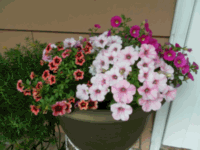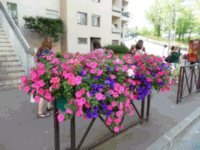
Checklist for March
1. Plant warm-season bedding plants beginning in mid-March and continuing through early May. For best results, plant petunias by mid-March and wait to plant periwinkles (vinca) until May.
2. After spring bulbs have finished flowering, wait until the foliage turns yellow before cutting it off. Food is being manufactured and stored for next year’s blooms.
3. Mulch plants to reduce watering requirements, suppress weed growth and minimize soil temperature changes. Excellent mulches are pine straw, chopped leaves and pine bark. Mulch should be applied at least 2 inches thick for effective weed suppression.
4. Divide and transplant older, larger clumps of chrysanthemums in early March. Failure to divide plants can result in weak, spindly growth with few flowers.
5. Coleuses are great annual bedding plants for Louisiana landscapes. Try some of the newer sun-loving varieties.
6. Fertilize shrubs during the spring using a general-purpose fertilizer. Carefully follow the label directions.
7. Watch for insect problems this spring. Lace bugs on azaleas and aphids or whiteflies on gardenias are common. Also examine camellias, sasanquas and hollies for scale insects on the lower foliage. Control with acephate, imidacloprid or horticultural oil sprays.
8. To encourage more rapid re-blooming, pinch off old flowers on bedding plants after their first flower cycle is completed this spring.
9. Roses may develop insect problems. Watch for aphids on tender new growth, thrips on flowers and cucumber beetles on foliage. Beetles are especially a problem if a vegetable garden is nearby. Treat with spinosad for beetles and thrips.
10. Garden centers will have many crape myrtles in May and June. Plant these shrubs and trees (depending on the variety you select) for great flowering all summer. Most varieties also have exfoliating, colored bark.
11. If your crape myrtles have had problems with crape myrtle aphids and the unattractive, black sooty mold they cause, treat your trees now to prevent problems this summer. Apply a drench of imidacloprid insecticide (Bayer Advanced Tree and Shrub Insect Control and other brands) to the base of the tree, and the tree will be protected from aphids all summer.
12. Treat trees, shrubs, vines and ground covers with horticultural oil sprays to control scale insects.
13. When planting flower or vegetable transplants in the garden, water them in with half strength soluble fertilizer solution to help them have a good start.

Spring Weeds
It is very important to focus on weed control this time of year around shrubs and in flower beds.
Cool-season weeds are in active growth as the days get longer and warmer, and they will begin to flower and set seeds. Left unchecked, the prolific seed production this spring will lead to even more problems next spring, so efforts made over the next couple of months are especially critical.
All garden beds should be mulched with about 2 to 3 inches of a mulching material, such as chopped leaves, pine straw, pine bark or other suitable materials. Mulches help considerably but are not totally weed-proof. If weeds manage to make it through the mulch, dig the weeds out promptly, making sure you get any bulbs or roots that might sprout again out of the ground.
You may also carefully apply an herbicide, such as glyphosate (Killzall, Eraser, Roundup and other brands), to just the weeds around your desired plants. Use shields or plastic bags to cover ornamentals in the bed to prevent the spray from contacting their foliage.
The use of a weed preventer, such as Preen or Amaze, will not be helpful in dealing with growing weeds. After you have weeded the bed, however, you can apply a weed-preventing herbicide to keep weeds from coming back. These products also can be applied to beds right after planting shrubs, ground covers or flowers to prevent weeds. (Do not apply to seeded beds, however, your seeds will not germinate.) Follow the label directions carefully and use these products only around plants that the label indicates are tolerant of the herbicide.
As you begin to see these cool-season weeds come into bloom, don’t put this job off any longer.

Planting Roses
Roses grown in containers may be planted at any time but seem to be more successful with winter plantings. This is also ideal time for transplanting existing roses and to finish any bare root plantings. Roses produce more flowers and are sturdier when grown in full sun or at least six to eight hours of sun. Early morning sun is preferred since it quickly dries any moisture on the plants thus reducing disease problems. When planting container roses, be careful not to disturb the root system as much as can be helped. The planting hole should be at least two times as large as the root ball. Add organic matter or raise planting bed for best drainage. Roses prefer slightly acidic soil (pH 6.0-6.8). Soils preparation can be done immediately before planting but is more effective if completed several months before to facilitate the plant’s absorption of organic materials and nutrients. Fertilize roses every four to six weeks during the growing season. Spray on a nearly weekly basis during the summer months to control pests. Very strict spraying schedule and annual pruning are required for good performance.
Petunias in the Landscape
Petunias are widely planted in this region as a cool season annual. Petunias grow best during the cool months of the year in full sunlight and a fertile, well drained, slightly acidic to alkaline soil. It has a moderate growth rate and can be propagated by seed or cuttings. Petunias can be used as a bedding plant or in containers for spring color. They cannot withstand the hot temperatures of summer, so are best when planted in late fall for blooming in winter and spring. Improved petunias are introduced every year providing hardier plants, new flower types and more color choices. Some varieties include the Wave series, Ultra series and The Tidal Wave group.

Prepare a raised bed with generous sand and organic matter to insure proper drainage. To maintain a low sturdy dense plant, pinch off the top terminal shoots of young plants after they have been planted for about two weeks and are about four to five inches tall. This will produce low sturdy side shoots as opposed to tall spindly plants which are weak and unable to tolerate heavy rains. Fertilize petunias every two to three weeks during the growing season using a mild liquid fertilizer. Excessive fertilizer can cause injury to tender roots and stems. Fertilizer placed below plants appear to be highly effective in providing nutrition over a long period of time. Disease problems include pythium, phytopthora and rizoctonia.
The wild petunia Ruellia carolinensis is a perennial that grows twelve to fifteen inches tall and produces trumpet shaped flowers or lavender-pink. The Mexican or summer petunia (R. brittoniana) produces low clumps of dark foliage in a variety of colors.
Cosmos pink calibrachoas and million bells produce plants that grow very much like petunias with an abundance of small pink, funnel shaped flowers with yellow centers. Other colors include blue, red, terra cotta, while and yellow.
Spring-flowering trees
Spring flowering trees bloom from late January to April. Here are some recommended varieties for our area. Redbud, dogwood, silver bell, Japanese magnolia, star magnolia, Taiwan flowering cherry, Okame flowering cherry, flowering pears, southern crabapple, hawthorn and fringe tree.
Spring-flowering trees
Plant these vegetable seeds during this month: cantaloupe, collards, corn, cucumber, cucuzzi, lima beans, mustard, pumpkin, radishes, snap beans, Southern peas, summer squash, Swiss chard, watermelons & winter squash. The following transplants are recommended for this month:
eggplant, kohlrabi, peppers and tomatoes. Mirlitons can be planted using the entire fruit with the sprouted end buried in the soil about 3 inches deep.
AAS Vegetable Award Winner: Pepper ‘Cayennetta’ F1
If you love the spicy flavor of peppers but don’t want so much heat, consider growing the new Cayennetta pepper (Capsicum annuum ‘Cayennetta’). It is an excellent tasting, mildly spicy pepper that is easy to grow. This variety produces chilli peppers about 3 to 4 inches long on a compact, well branched, upright plant. The tapered, bayonet-shaped fruit start off green, mature bright red and are produced in great quantities. Plants produce best with eight hours or more of direct sun (full sun) and grow to be about 24 inches tall and about 20 inches wide.
A unique character of this variety is that it has good cold tolerance. This is important for gardeners planting as early as possible in the spring and a good characteristic for late summer plantings for fall production. Also notable is the dense foliage cover to protect the fruit from sun scorch. It also handles extreme heat well.
submitted by Karen Blackburn
